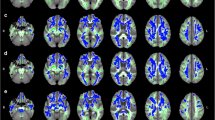Abstract
Assertions regarding attempts to link glial and macrostructural brain events with cognitive performance regarding Albert Einstein, are critically reviewed. One basic problem arises from attempting to draw causal relationships regarding complex, delicately interactive functional processes involving finely tuned molecular and connectivity phenomena expressed in cognitive performance, based on highly variable brain structural events of a single, aged, formalin fixed brain. Data weaknesses and logical flaws are considered. In other instances, similar neuroanatomical observations received different interpretations and conclusions, as those drawn, e.g., from schizophrenic brains. Observations on white matter events also raise methodological queries. Additionally, neurocognitive considerations on other intellectual aptitudes of A. Einstein were simply ignored.
Similar content being viewed by others
References
Anderson B, Harvey T (1996) Alterations in cortical thickness and neuronal density in the frontal cortex of Albert Einstein. Neurosci Lett 21:161–164
Bender AR, Raz N (2015) Normal-appearing cerebral white matter in healthy adults:mean change over 2 years and individual differences in change. Neurobiol Aging 36:1834–1848
Bender AR, Völkle MC, Raz N (2016) Differential aging of cerebral white matter in middle-aged and older adults: a seven-year follow-up. Neuroimage 125:74–83
Byne W, Bleier R, Houston L (1988) Variations in human corpus callosum do not predict gender: a study using magnetic resonance imaging. Behav Neurosci 102:222–227
Colombo JA (2000) Comentarios a propósito del cerebro de Albert Einstein. Medicina 60:530–532
Colombo JA (2001) A columnar-supporting mode of astroglial architecture in the cerebral cortex of adult primates? Neurobiol 9:1–16
Colombo JA (2017a) Creatividad o domesticación. Buenos Aires Books, Buenos Aires (ISBN 978-987-46237-5-1)
Colombo JA (2017b) The interlaminar glia: from serendipity to hypothesis. Brain Str Funct 222:1109–1129. https://doi.org/10.1007/s00429-016-1332-8
Colombo JA, Yañez A, Lipina S (1997) Interlaminar astroglial processes in the cerebral cortex of non human primates: response to injury. J Brain Res 38:503–512
Colombo JA, Napp MI, Yañez A, Reisin H (2001) Tissue printing of astroglial interlaminar processes from human and non-human primate cerebral cortex. Brain Res Bull 55:561–565
Colombo JA, Quinn B, Puissant V (2002) Disruption of astroglial interlaminar processes in Alzheimer’s disease. Brain Res Bull 58:235–242
Colombo JA, Reisin HD, Miguel-Hidalgo JJ, Rajkowska G (2006) Cerebral cortex astroglia and the brain of a genius: a propos of A. Einstein’s. Brain Res Rev 52:257–263
Cragg BG (1975) The density of synapses and neurons in normal mentally defective ageing human brains. Brain 96:81–90
Diamond MC, Scheibel AB, Murphy GM, Harvey T (1985) On the brain of a scientist: Albert Einstein. Exp Neurol 88:198–204
Einstein A (1987) The collected papers of Albert Einstein. Vol 1: the early years, 1879–1902 (English translation supplement, by Anna Beck). Princeton University Press, Princeton. http://einsteinpapers.press.princeton.edu/vol1-trans/34%23
Falk D, Lepore FE, Noe A (2013) The cerebral cortex of Albert Einstein: a description and preliminary analysis of unpublished photographs. Brain 136:1304–1327
Galaburda AM (1999) Albert Einstein’s brain. Lancet 354:1821 (author reply 1. PMID 10577668)
Gärtner H, Minnerop M, Pieperhoff P, Schleicher A, Zilles K, Altenmüller E, Amunts K (2013) Brain morphometry shows effects of long-term musical practice in middle-aged keyboard players. Front Psychol. https://doi.org/10.3389/fpsyg.2013.00636
Gaser C, Schlaug G (2003) Brain structures differ between musicians and non-musicians. J Neurosci 23:9240–9245
Gupta T, Singh B, Kapoor K, Gupta M, Kochar S (2008a) Corpus callosum morphometry:comparison of fresh brain, preserved brain and magnetic resonance imaging values. Anat Sci Int 83:162–168. https://doi.org/10.1111/j.1447-073X.2008.00227.x
Gupta T, Singh B, Kapoor K, Gupta M, Kochhar S (2008b) Age and sex related variations in corpus callosal morphology. Nepal Med Coll J 10:215–221
Hines T (1998) Further on Einstein’s brain. Exp Neurol 150:343–344
Hines T (2014) Neuromythology of Einstein’s brain. Brain Cognit 88:21–25
Koelsch S, Fritz T, Schulze K, Alsop D, Schlaug G (2005) Adults and children processing musician fMRI study. Neuroimage 25:1068–1076
Luders E, Narr KL, Bilder RM, Thompson PM, Szeszko PR, Hamilton L, Toga AW (2007) Positive correlations between corpus callosum thickness and intelligence. Neuroimage 37:1457–1464
Men W, Falk D, Sun T, Chen W, Li J, Yin D, Zang L, Fan M (2014) The corpus callosum of Albert Einstein‘s brain: another clue to his high intelligence? Brain 137:1–8
Münte TF, Altenmüller E, Jäncke L (2002) The musician’s brain as a model of neuroplasticity. Nat Rev Neurosci 3:473–479
Posner MI, Tang YY, Lynch G (2014) Mechanisms of white matter change induced by meditation training. Front Psychol 5:1220. https://doi.org/10.3389/fpsyg.2014.01220
Reisin HD, Colombo JA (2002) Considerations on the astroglial architecture and the columnar organization of the cerebral cortex. Cell Mol Neurobiol 22:633–644
Reuter-Lorenz PA, Stanczak L (2000) Differential effects of aging on the functions of the corpus callosum. Dev Neuropsychol 18:113–137
Schlaug G (2001) The brain of musicians a model for functional and structural adaptation. Ann NY Acad Sci 930:281–299
Selemon LD, Rajkowska G, Goldman-Rakic P (1998) Elevated neuronal density in prefrontal area46 in brains from schizophrenic patients: application of a three-dimensional stereological counting method. J Comp Neurol 392:402–412
Tang YY, Lu Q, Fan M, Yang Y, Posner MI (2012) Mechanisms of white matter changes induced by meditation. Proc Natl Acad Sci USA 109:10570–10574
Weible AP, Piscopo DM, Rothbart MK, Posner MI, Niell CM (2017) Rhythmic brain stimulation reduces anxiety-related behavior in a mouse model based on meditation training. PNAS 114:2532–2537
Witelson SF, Kigar DL, Harvey T (1999) The exceptional brain of Albert Einstein. The Lancet 353:2149–2153
Acknowledgements
Support by Fundación Conectar.
Author information
Authors and Affiliations
Corresponding author
Ethics declarations
The author declares compliance with ethical standards.
Conflict of interest
The author declares no conflict of interest.
Informed consent
Informed consent was obtained from all individual participants included in the study.
Rights and permissions
About this article
Cite this article
Colombo, J.A. A critical view of the quest for brain structural markers of Albert Einstein’s special talents (a pot of gold under the rainbow). Brain Struct Funct 223, 2515–2518 (2018). https://doi.org/10.1007/s00429-018-1625-1
Received:
Accepted:
Published:
Issue Date:
DOI: https://doi.org/10.1007/s00429-018-1625-1




